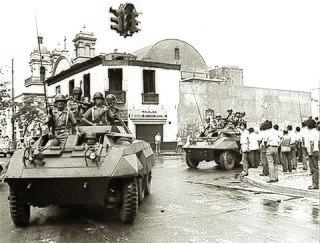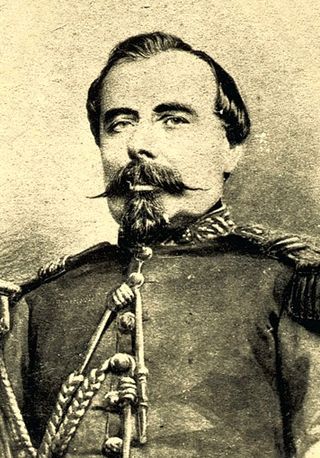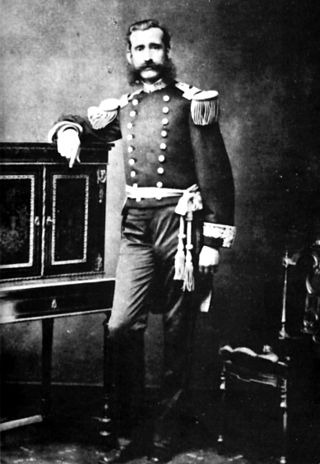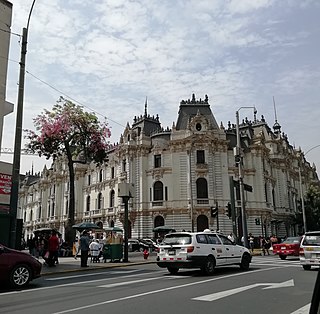Juan Francisco de Vidal | |
|---|---|
 | |
| 8th President of Peru | |
| In office 20 October 1842 –15 March 1843 |
Juan Francisco de Vidal | |
|---|---|
 | |
| 8th President of Peru | |
| In office 20 October 1842 –15 March 1843 |

Francisco Remigio Morales Bermúdez Cerruti was a Peruvian politician and general who was the de facto President of Peru between 1975 and 1980, after deposing his predecessor, General Juan Velasco. His grandfather and all his original family were from the old Peruvian department of Tarapacá, which is now part of Chile. Unable to control the political and economic troubles that the nation faced, he was forced to return power to civilian rule, marking the end of the Revolutionary Government of the Armed Forces installed by a coup d'état in 1968.

The Tacnazo was a military coup launched by then Peruvian Prime Minister, General Francisco Morales Bermúdez against the administration of President Gen. Juan Velasco Alvarado in 1975. This led to what is known in Peru as the "Second Phase" of the Revolutionary Government of the Armed Forces, which lasted until the elections of 1980.

The Historic Centre of Lima is the historic city centre of the city of Lima, the capital of Peru. Located in the city's districts of Lima and Rímac, both in the Rímac Valley, it consists of two areas: the first is the Monumental Zone established by the Peruvian government in 1972, and the second one—contained within the first one—is the World Heritage Site established by UNESCO in 1988, whose buildings are marked with the organisation's black-and-white shield.

Francisco Bolognesi Cervantes was a Peruvian military colonel. He is considered a national hero in Peru and was declared patron of the Army of Peru by the government of Peru on January 2 of 1951.

Manuel Ignacio de Vivanco Iturralde was a Peruvian politician and military leader who served as the President of Peru from 1843 to 1844. He was born in Lima, Peru. He led part of the Peruvian forces in the campaign against the reunification of Peru-Bolivian Confederacy.

The club is the first soccer representative of the first port of Peru, Callao, which laid the foundations for future Chalacos clubs, going from being a school club to being a professional club, gaining recognition, prestige and trust among fans of the Callao, from Lima and Peru, since today there are many clubs with the name of Atlético Chalaco, but only one is the original and traditional. [At present, Atlético Chalaco is called the "Historical Soccer Heritage of the Constitutional Province of Callao ".

Club Centro Deportivo Municipal, commonly known as Deportivo Municipal, is a Peruvian football club based in Lima, Peru. They are among Peru's most recognizable clubs and enjoy considerable popularity. The bulk of their success was won a few years after the club was founded in 1935. The club was a top-flight contender during this period and won four Primera División titles. The club suffered relegation three times in their history: 1967, 2000, and 2007. They have also been champions of the Segunda División on three occasions: 1968, 2006, and 2014, granting them promotion to the first division. In 2014, they won the Segunda División and they currently compete in the Primera División Peruana.

Juan Crisóstomo Torrico Vargas served as the 16th President of Peru during a brief period in 1842. At age 34, he was Peru's youngest President ever.

Juan Lizardo Montero Flores was a Peruvian soldier and politician who held the provisional Presidency of Peru from 1881 to 1883, replacing President Francisco García Calderón, during the Chilean occupation of Peru that took place as a result of the War of the Pacific. He was also Mayor of Lima for a brief period, in 1879.

Francisco Diez Canseco Corbacho served as Interim President of Peru for a brief period during 1872. He was the brother of General Pedro Diez Canseco.

The Roman Catholic Archdiocese of Trujillo is an archdiocese located in the city of Trujillo in Peru.

Italian Peruvians are Peruvian-born citizens who are fully or partially of Italian descent, whose ancestors were Italians who emigrated to Peru during the Italian diaspora, or Italian-born people in Peru. Among European Peruvians, Italians were the second largest group of immigrants to settle in the country. Italian immigration in Peru began in the colonial era, during the Spanish Viceroyalty of Peru.

Tomás Francisco Gutiérrez Chávez was a Peruvian Colonel who, along with his brothers, led a coup against President José Balta Montero and served as the Supreme Leader of Peru for four days in July 1872. From July 22, 1872 to July 26, 1872, Gutiérrez was the de facto leader of Peru and the self-proclaimed "Supreme Leader of the Republic" after a coup d'état. He was overthrown just four days after his proclamation and lynched. Peru later regained some political stability with the election of Manuel Pardo, although this stability was short-lived as a foreign threat began to arise in Chile.

A Spanish Peruvian is a Peruvian citizen of Spanish descent. Among European Peruvians, the Spanish are the largest group of immigrants to settle in the country.

The Jirón de la Unión, or Union Street, is a pedestrian street located in the Historic Centre of Lima, part of the capital of Peru. For many decades it was the most important boulevards of the city, often described as the most aristocratic, where many of the most affluent citizens of the city and most powerful men around the world would meet. Subsequently, with the deterioration of the center of Lima, the Jirón de la Unión lost its aristocratic character and became completely commercialized.

The Plaza Mayor de Lima, or Plaza de Armas de Lima, is considered one of the birthplaces of the city of Lima, as well as the core of the city. Located in the Historic Centre of Lima, it is surrounded by the Government Palace, Lima Metropolitan Cathedral, Archbishop's Palace of Lima, the Municipal Palace, and the Palacio de la Unión.

The Basilica and Priory of Nuestra Señora de la Merced is a Roman Catholic church located in Lima, Peru. It was designed in the Baroque style known as Churrigueresque. The church was built under the supervision of Friar Miguel de Orenes in 1535. The Blessed Virgin Mary of Mercy, the patroness of the Peruvian Armed Forces, is venerated in the Basilica. The Mercedarians, who evangelized the region, helped to develop Lima by building many of the churches preserved today.
The following lists events that happened during 1898 in Chile.
The following lists events that happened during 1966 in Chile.

The Lima campaign is the third land campaign of the War of the Pacific, carried out by Chile between December 1880 and January 1881. The campaign ended with the Chilean occupation of the Peruvian capital and the establishment of the Chilean authority in it and other surrounding territories, which would extend until 1883, with the end of the war.